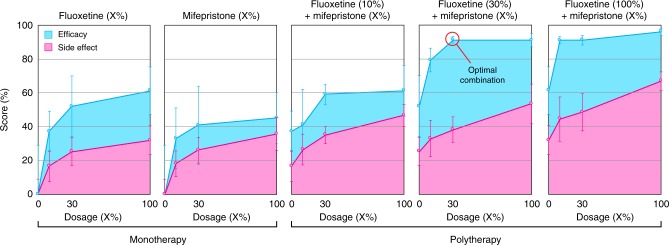Fig. 3.
Network-engineered polytherapy achieves superior therapeutic outcomes. Semi-log dose-response data showing efficacy scores (cyan) and side effect scores (magenta) for fluoxetine and mifepristone alone (monotherapy) and combinatorially over all investigated doses (polytherapy) at ~4 h post-exposure. For each compound, the highest dosage (100%) corresponds to the concentration used in the initial light-sheet-based screen (see Supplementary Table 1). Efficacy is calculated from local field potential recordings using an automated seizure detection algorithm to count spontaneous seizures over a 45-min interval. The side effect score is based on six distinct behavioral metrics quantified over a 30-min interval using an automated video tracking platform. Both scores are determined under resting state conditions (i.e. in the absence of light stimuli) and calculated as described in Methods. Scores have been normalized to untreated age-matched larvae (n = 5+ larvae per condition for efficacy; n = 10 larvae per condition for side effect). Several polytherapy combinations show substantially greater therapeutic efficacy while maintaining behavioral profiles that are in the same range as monotherapy regimens. The combination of fluoxetine and mifepristone, both at the 30% dosage (optimal combination), is significantly more effective than either mifepristone alone (p = 0.000106; unpaired two-tailed Student's t-test) or fluoxetine alone (p = 0.000105; unpaired two-tailed Student's t-test) at the same dosages. The error bars represent standard deviation. Source data are provided as a Source Data file

